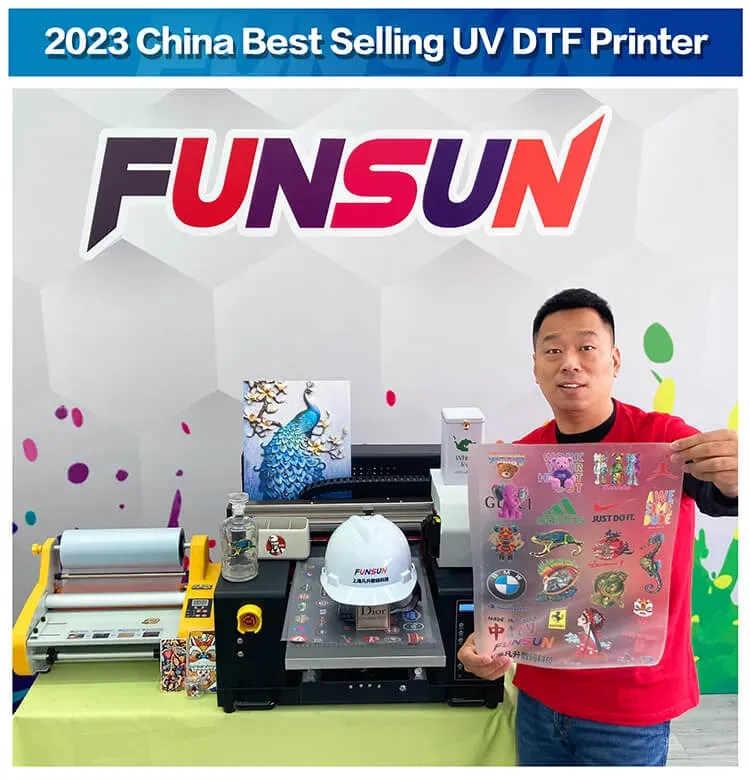UV DTF printing, or Ultraviolet Direct-to-Film printing, is transforming the landscape of custom product printing in today’s creative industry. This innovative printing technique utilizes advanced UV printing technology to transfer designs onto a variety of surfaces through a specialized film. With the ability to achieve vibrant colors and intricate details, UV DTF applications are broad, catering to sectors ranging from apparel to promotional items. Moreover, the introduction of personal 3D texture printers enables users to explore new dimensions in their designs, making every project unique. As businesses seek to enhance their offerings, UV DTF printing stands out as a powerful tool for creative expression and customization.
Exploring the realm of direct-to-film printing reveals a vibrant and evolving technology that merges creativity with practicality. Often referred to as UV printing technology, this method allows for high-resolution prints that can be seamlessly applied to various materials without extensive preparation. The versatility of application means that creators can utilize this technique for everything from bespoke merchandise to industrial products, making it an essential asset in the world of printing. With the rise of personal 3D texture printers, the potential for tailored designs is expanding, inviting even small-scale entrepreneurs to engage in professional-quality production. This shift towards customization and accessibility in UV DTF printing highlights an exciting direction for both artists and businesses alike.
Understanding UV DTF Printing Technology
UV DTF printing, or Ultraviolet Direct-to-Film printing, represents a new era in the realm of printing technologies. This innovative method merges the principles of UV printing technology with Direct-to-Film (DTF) printing processes, providing impressive versatility and durability across various substrates. The process involves printing vibrant designs on a special film using UV-curable inks, which are then transferred onto materials like wood, glass, and metal. This capability allows for intricate details and rich colors, making it a preferable choice for businesses seeking high-quality output.
Furthermore, the ability to print directly onto different surfaces without the need for pre-treatment is a significant advantage. This efficiency not only saves time and resources but also broadens the scope of applications. Whether for creating custom products, promotional materials, or home decor items, UV DTF technology delivers superior results that meet the demands of modern consumers.
Key Features of UV DTF Printing
One of the standout features of UV DTF printing technology is its exceptional compatibility with a range of materials. Unlike traditional printing methods that may require extensive preparation and finishing processes, UV DTF printing allows users to generate high-quality prints directly onto various substrates. This includes everything from textiles to plastics, enhancing the usability of the technology for custom product printing, which is increasingly in demand.
Additionally, recent developments in personal 3D texture printers, such as the **eufyMake UV Printer E1**, have revolutionized the market by enabling the production of tactile and dimensional prints with ease. This innovative printer integrates various functionalities, including rotary printing, while maintaining a compact form, catering to the growing needs of hobbyists and small business owners who require efficient production devices.
Comparing UV DTF and Other Printing Methods
When evaluating printing technologies, understanding the differences between UV DTF printing and other methods such as traditional screen printing or direct-to-garment (DTG) printing is crucial. UV DTF stands out due to its quick drying times and the durability of its prints. The UV-curable inks used in this process offer resistance to water and fading, making it ideal for items that will be used outdoors or exposed to varying environmental conditions.
In contrast, traditional methods may require longer drying times and may not offer the same level of detail and color vibrancy as UV DTF printing. Additionally, UV DTF printing does not necessitate extensive pre-treatment, allowing for a more streamlined production process that is both efficient and cost-effective.
Applications of UV DTF Printing in Various Industries
UV DTF printing showcases its versatility across multiple industries, making it a sought-after technology for custom product creation. From signage manufacturers to apparel decorators, the applications are vast and continually evolving. The ability to print intricate designs directly on various materials without needing pre-treatment opens doors for personalized products, such as custom stickers, labels, and promotional items that cater to the needs of individuals and businesses alike.
Moreover, UV DTF technology is particularly beneficial for home decor and interior design projects, allowing designers to create customized pieces that cater to specific aesthetic preferences. This flexibility empowers creators to push the boundaries of traditional printing, encouraging innovation and creativity in product design.
The Future of UV DTF Printing Technology
The future of UV DTF printing technology looks promising, with continual advancements in UV printing technology and associated equipment. Recent exhibitions, such as the Fespa Global Print Expo, have showcased cutting-edge UV printers that are enhancing the capabilities of DTF options, indicating a trend toward more customizable and accessible printing technologies. This proliferation could lead to an increase in small businesses harnessing this power, thereby transforming industry dynamics.
As consumer demand for personalized products rises, UV DTF printing will play a pivotal role in fulfilling this need. The sector is likely to see innovations in ink formulations, printer functionalities, and cost-efficiency, all aimed at enhancing user experience and output quality. Consequently, businesses venturing into this technology should stay informed of these advancements to leverage the benefits effectively.
Benefits of Utilizing UV DTF Printing in Your Business
Implementing UV DTF printing technology in your business can yield significant advantages. The durability of UV-cured inks ensures that printed products withstand the test of time, resisting fading and environmental damage. This aspect is particularly attractive for businesses aiming to provide quality materials to their customers, allowing for guaranteed longevity in every product shipped.
In addition to durability, UV DTF printing supports high-resolution outputs that capture intricate designs and colors. The speed at which productions can be completed also enhances operational efficiency, making it an essential tool for businesses that need to meet tight deadlines in today’s fast-paced market.
Frequently Asked Questions
What are the key benefits of using UV DTF printing technology?
UV DTF printing technology offers several benefits, including exceptional durability of prints due to UV-cured inks that resist fading and water damage. It also provides high-quality output with vibrant colors and intricate details, ensuring your designs stand out. Additionally, the speed of UV DTF printing allows for quicker product turnarounds, meeting tight deadlines, while its eco-friendly practices cater to the increasing demand for sustainability in custom product printing.
How does UV DTF printing differ from traditional direct-to-film printing methods?
UV DTF printing combines UV printing technology with traditional direct-to-film processes, resulting in enhanced durability and versatility. Unlike traditional DTF methods, UV DTF printers utilize UV-curable inks that bond effectively to various substrates, eliminating the need for extensive pre-treatment. This not only streamlines the printing process but also allows for printing on a wider range of materials, such as glass, metal, and plastics, opening up new UV DTF applications.
What materials can be used with UV DTF printing?
UV DTF printing is incredibly versatile, allowing users to print on a wide array of materials including wood, glass, plastic, metal, and fabrics. This capability makes it ideal for various UV DTF applications, from custom apparel and promotional materials to decorative home decor items, making it a popular choice for businesses seeking to create unique products.
Is a specific printer required for UV DTF printing processes?
Yes, UV DTF printing requires a dedicated printer designed for this technology. The latest innovations, such as the eufyMake UV Printer E1, specifically cater to the needs of personal 3D texture printing, allowing for the application of UV-curable inks on various films and substrates. These printers are designed to handle the unique demands of UV DTF printing while providing high-quality results and user-friendly operations.
What industries benefit the most from UV DTF printing?
UV DTF printing technology is beneficial across multiple industries, particularly in custom product printing, apparel, promotional materials, signage, and home decor. Its versatility and high-quality output make it an attractive option for small businesses and individual creators looking to offer personalized products and stand out in competitive markets.
Can UV DTF printers produce large-scale prints?
Yes, many UV DTF printers are capable of producing large-scale prints, especially models designed for industrial applications. However, the size and capabilities vary among different printers, so it is essential to choose a model that aligns with your specific printing needs, whether for small-scale or large-scale production.
| Key Point | Details |
|---|---|
| What is UV DTF Printing? | A technique combining UV printing technology with Direct-to-Film processes, allowing designs to be printed on various surfaces using UV-curable inks. |
| Key Developments | Emergence of the eufyMake UV Printer E1, the world’s first personal 3D texture UV printer, opens new opportunities for customization and innovation in printing. |
| Innovative Features and Applications | Can print directly onto various materials and peel-off films for personalized product creation, enhancing usability in custom designs. |
| Industry Trends | Increased focus on customizable and accessible UV printing technologies, as showcased at events like the Fespa Global Print Expo. |
| Applications | Excellent for printing on a multitude of substrates in industries requiring customization like apparel and home decor. |
| Benefits of UV DTF Printing | 1. Durability, 2. High-Quality Output, 3. Speed, 4. Sustainability. |
Summary
UV DTF printing is an innovative printing technique that offers a high degree of versatility and quality in printing designs on various surfaces. With the advancements in technology, such as the emergence of specialized printers like the eufyMake UV Printer E1, it’s become easier than ever for small businesses and individual creators to produce customized products with vibrant colors and intricate details. The unique capabilities of UV DTF printing not only cater to the demands of modern consumers but also provide a sustainable solution, appealing to businesses looking to reduce waste. As the application of this technology expands across diverse industries, it holds immense potential for changing the landscape of personalization and product design, making it an exciting area to explore for anyone interested in the future of printing.



